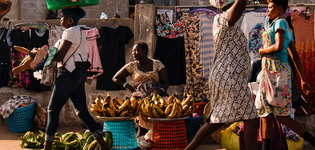Blog
Data for development
The first of the Sustainable Development Goals (SDGs) is to end poverty in all its forms, everywhere. The monumental task — a long-time dream of humanity — is followed by 16 more goals under the 2030 Agenda. Though they are all interlinked, to even contemplate their achievement requires a deep well of hope.
Crucially for their achievement, the SDGs are said to represent ‘an unprecedented statistical challenge’. In addition to the 17 goals, there are 169 targets and 232 accompanying indicators for statistical agencies and specialists to fret over. This is one reason the former United Nations Secretary-General Ban Ki-Moon called for a ‘data revolution for sustainable development’ and convened an Independent Expert Advisory Group in 2014 to make concrete recommendations.
Overcoming the data challenge
On one hand, a lot more high-quality data are needed just to monitor progress on the SDGs. But even before that, data are critical to conducting useful analysis on what kind of interventions are likely to bring the achievement of the SDGs closer.
In one striking example of the need for better data, two-thirds of the data used to measure global poverty — and therefore progress on SDG1 — is inferred. One of our experts called attention to this ‘underlying monumental problem’ in a recent article. Andy Sumner points out that, ‘the World Bank has over 6,000 distributions in its database but only a third — about 2,000 — are real survey data’. Two-thirds of the country-year pairs in the database, then, are extrapolated or interpolated (see figure below).
Our contributions to the data revolution
At UNU-WIDER, we support the argument that access to data should be a fundamental public right. On this principle — that data are a public good — many national and international agencies make the data they collect or compile freely available. UNU-WIDER’s mission and work is no exception. In addition to relying on global data to produce high-quality research that offers actionable insights, our institute is an active participant in the data revolution.
Across the entirety of our current work programme, and indeed our 36-year history, UNU-WIDER’s dedication to data advancement — now in pursuit of the SDGs — is ubiquitous. We host, update, and maintain as a public good two of the world’s most extensive databases: one on government revenues and the other on inequality. This year, we also partnered with the Groningen Growth and Development Centre to launch the Economic Transformation Database, which provides data on the employment and value-added shares, by sector, for 51 developing countries.
Our SOUTHMOD project, conducted in partnership with the University of Sussex and SASPRI, brings the EUROMOD software to national policy teams around the Global South. The software makes possible the use of tax-benefit microsimulations by decision makers to compare policy options that might improve social protection. SOUTHMOD has developed this tool with decision makers in Ecuador, Ethiopia, Ghana, Mozambique, Tanzania, Uganda, Viet Nam, and Zambia. The project is a demonstration of how data can be used to promote progress on the SDGs.
This year, we also celebrate the conclusion of phase one of Southern Africa – Towards Inclusive Economic Development (SA-TIED), a programme which has made South Africa a data role model for other countries outside the OECD. SA-TIED is a close partnership between UNU-WIDER, South African government departments, and other organizations and institutes. The project demonstrated how the policymaking and research community can work together to securely release national tax administrative data — records on the country’s entire set of tax-registered firms and individuals — and produce pioneering economic policy studies with it. With SA-TIED, South Africa became the first low- or middle-income country to release its tax administrative data for research purposes.
As a trendsetting project in this area, SA-TIED demonstrates how research with tax administrative data can improve policymaking. These data were instrumental to new tax and benefit policies in South Africa. They were brought to bear in the national response to COVID-19, which included a new social transfer that reduced national poverty even as the economy faltered from the pandemic’s fallout. The data helped provide critical insights on how to bring about more inclusive economic development and advance the SDGs.
The project has been a paragon, inspiring Uganda, Tanzania, and Zambia to join us in similar partnerships.
Hallmark databases
The Government Revenue Dataset (GRD) and the World Income Inequality Database (WIID) are two of our hallmark data projects, ongoing for many years. Originally developed by the International Centre for Tax and Development, the GRD was a response to concerns about revenue data quality and availability. Before the GRD, much of the data on government revenue in developing countries was kept by the International Monetary Fund (IMF) and sometimes it was exclusively available to IMF research staff. UNU-WIDER is happy to host, update, and maintain the GRD since 2016.
The choice to do so was partly due to the success of the WIID database, which UNU-WIDER has housed for over 20 years. The WIID and the GRD both demonstrate our commitment to the idea that data is a public good. The WIID collects and stores information on income inequality for developed, developing, and transition countries. It is the most extensive collection of inequality statistics in the world and includes the main data on income distributions which are available for most countries.
The WIID project is critical for those who wish to understand inequality trends over time and to study its drivers. The WIID is often used in major United Nations reports to monitor progress on SDG10 (reducing inequality).
In 2021 we continued this work by releasing two datasets which standardize, or harmonize, the data in the WIID. These datasets, collectively referred to as the WIID Companion, offer the complete global income distribution over time, as well as national and regional distributions, with observations at the percentile level (the income level of each 1% of the entire world population).
Across the entirety of our current work programme and our history, UNU-WIDER’s dedication to data advancement is demonstrable. Through our work, the prospects for achieving the SDGs are meaningfully improved.
The views expressed in this piece are those of the author(s), and do not necessarily reflect the views of the Institute or the United Nations University, nor the programme/project donors.
 Join the network
Join the network





